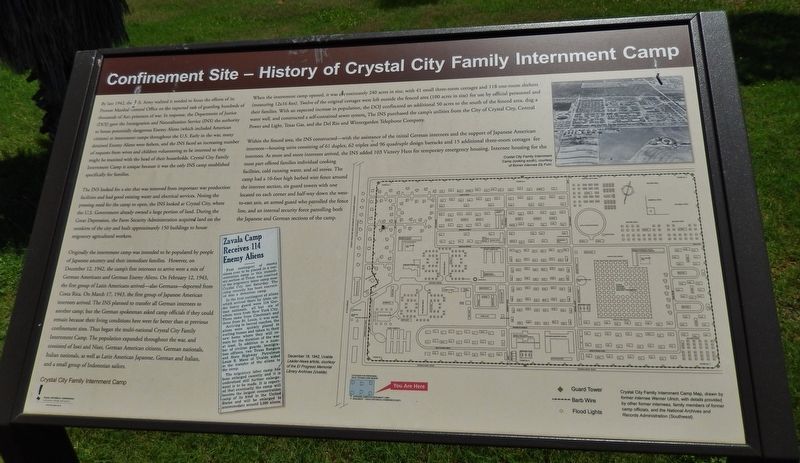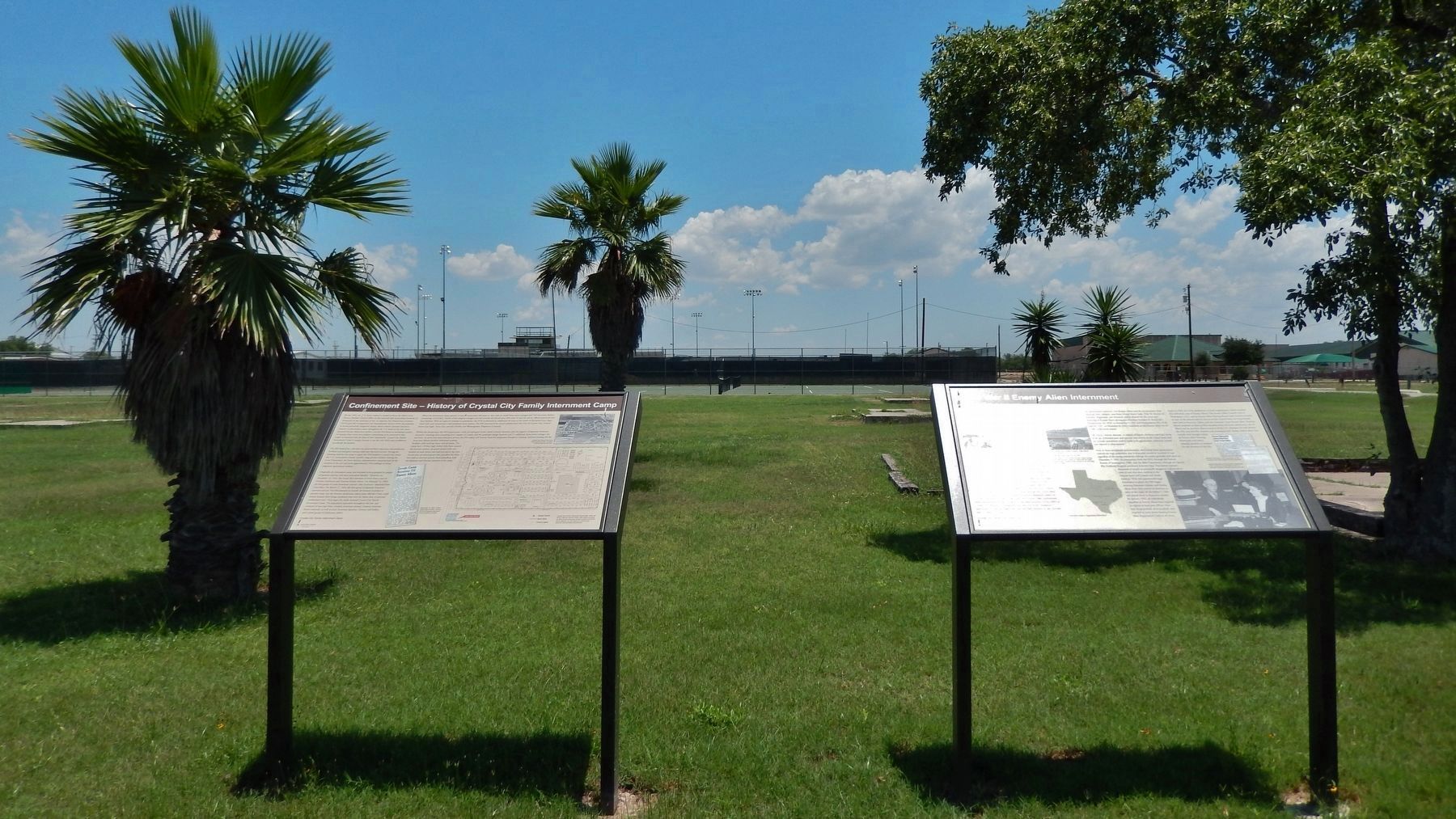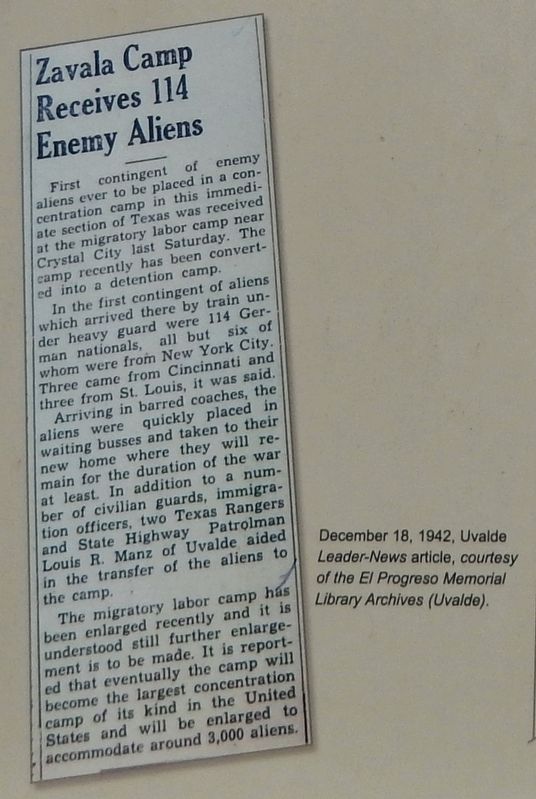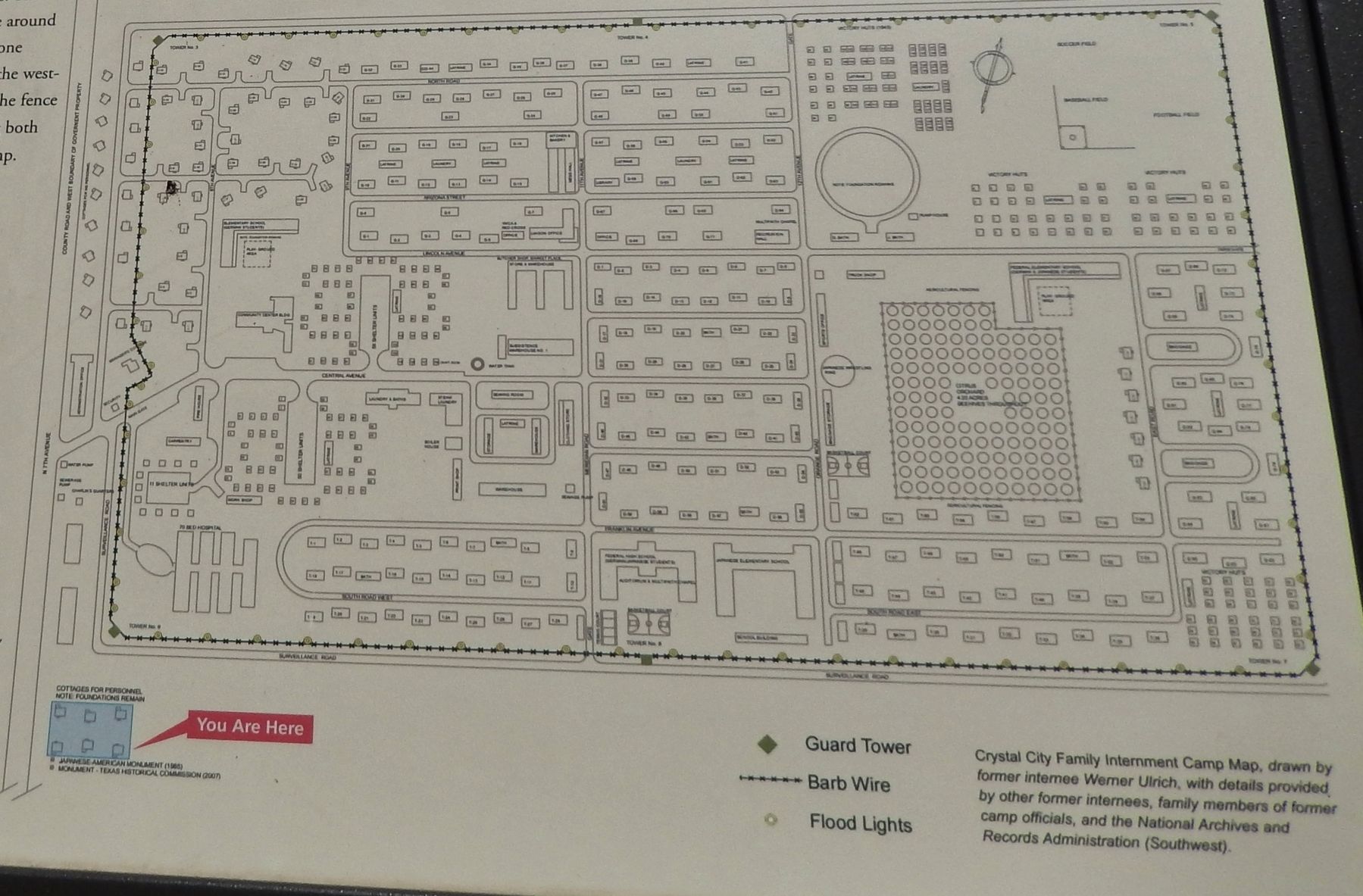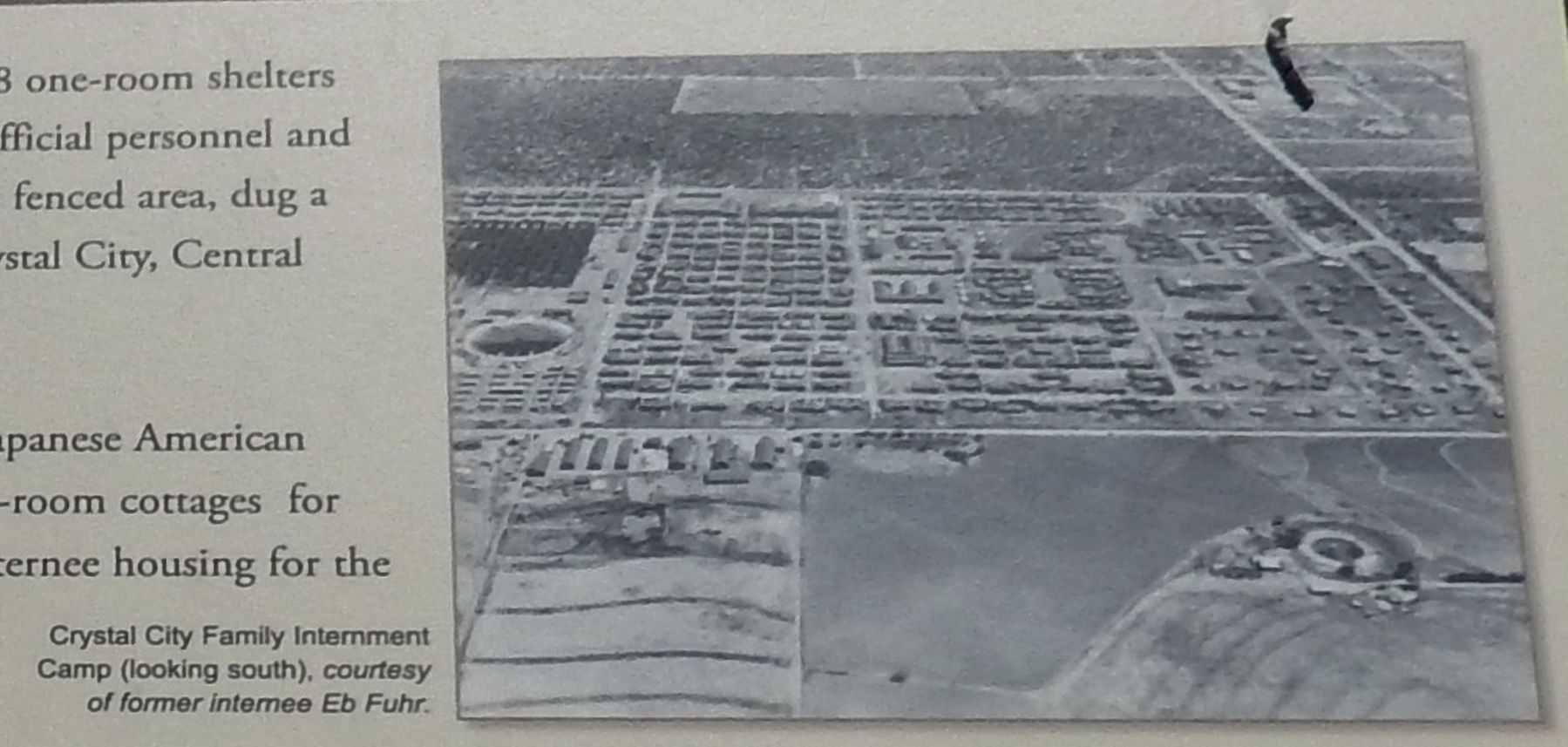Crystal City in Zavala County, Texas — The American South (West South Central)
Confinement Site - History of Crystal City Family Internment Camp
Inscription.
By late 1942, the U.S. Army realized it needed to focus the efforts of its Provost Marshal General's Office on the expected task of guarding hundreds of thousands of Axis prisoners of war. In response, the Department of Justice (DOJ) gave the Immigration and Naturalization Service (INS) further authority to house potentially dangerous Enemy Aliens (which included American citizens) at internment camps throughout the U.S. Early in the war, many detained Enemy Aliens were fathers, and the INS faced an increasing number of requests from wives and children volunteering to be interned so they might be reunited with the head of their households. Crystal City Family Internment Camp is unique because it was the only INS camp established specifically for families.
The INS looked for a site that was removed from important war production facilities and had good existing water and electrical services. Noting the pressing need for the camp to open, the INS looked at Crystal City, where the U.S. Government already owned a large portion of land. During the Great Depression, the Farm Security Administration acquired land on the outskirts of this small southwest Texas town and built approximately 150 buildings to house migratory agricultural workers.
Originally the internment camp was intended to be populated by people of Japanese ancestry and their immediate families. However, on December 12, 1942, the camp’s first internees to arrive were a mix of German Americans and German Enemy Aliens. On February 12, 1943, the first group of Latin Americans arrived—also Germans—deported from Costa Rica. On March 17, 1943, the first group of Japanese American internees arrived. The INS planned to transfer all German internees to another camp, but the German spokesman asked camp officials if they could remain because their living conditions here were far better than at previous confinement sites. Thus began the multi-national Crystal City Family Internment Camp. The population expanded throughout the war, and consisted of Issei and Nisei, German American citizens, German nationals, Italian nationals, as well as Latin American Japanese, German and Italian, and a small group of Indonesian sailors.
When the internment camp opened in December 1942, the site was approximately 240 acres in size, with 41 small three-room cottages and 118 one-room shelters (measuring 12x16 feet). Twelve of the original cottages were left outside the fenced area (100 acres in size) for use by official personnel and their families. With an expected increase in population the DOJ confiscated an additional 50 acres to the south of the fenced area, dug a water well, and constructed a self-contained sewer system. The INS purchased
the camp’s utilities from the City of Crystal City, Central Power and Light, Texas Gas, and the Del Rio and Wintergarden Telephone Company.
Within the fenced area, the INS constructed—with the assistance of the initial German internees and the support of Japanese American internees—housing units consisting of 61 duplex, 62 triplex and 96 quadruple design barracks, and 15 additional three-room cottages for internees. As more and more internees arrived, the INS added 103 Victory Huts for temporary emergency housing. Internee housing for the most part offered families individual cooking facilities, cold running water, and oil stoves. The camp had a 10-foot high barbed wire barrier around the internee section, six guard towers with one located on each corner and half-way down the west-to-east axis, an armed guard who patrolled the fence line, and an internal security force patrolling both the Japanese and German sections of the camp.
Erected 2011 by Texas Historical Commission.
Topics. This historical marker is listed in these topic lists: Asian Americans • War, World II. A significant historical year for this entry is 1942.
Location. 28° 41.466′ N, 99° 49.493′ W. Marker is in Crystal City, Texas, in Zavala County. Marker is at the intersection of North 7th Avenue (Farm to Market Road 1433) and Popeye Lane, on the right when traveling north on North 7th Avenue. The marker is located inbthe southwest corner of a vacant lot (the former internment camp site), adjacent to the Crystal City High School Baseball field. Touch for map. Marker is at or near this postal address: 104 Popeye Lane, Crystal City TX 78839, United States of America. Touch for directions.
Other nearby markers. At least 7 other markers are within 12 miles of this marker, measured as the crow flies. World War II Enemy Alien Internment (a few steps from this marker); World War II Concentration Camp (a few steps from this marker); Crystal City Family Internment Camp, World War II (a few steps from this marker); Living and Working in an Internment Camp (about 600 feet away, measured in a direct line); Zavala County (approx. 0.8 miles away); Burleson Cemetery (approx. 9.6 miles away); Dimmit County Courthouse (approx. 11.9 miles away).
Related markers. Click here for a list of markers that are related to this marker.
Also see . . .
1. Crystal City Family Internment Camp. (includes photos and details about this internment camp)
From its inception in mid-1942 through June 1945, Crystal City (Family) Internment Camp interned 4,751 (this included 153 people born in the camp). The camp’s population peaked at 3,374 on December 29, 1944, more than two thirds of which were of Japanese nationality or ancestry. Approximately 11,507 German Americans were interned in the U.S. during the war, accounting for 36 percent of the total internments under the DOJ Alien Enemy
Control Unit Program. In addition, an estimated 4,500 ethnic Germans and Italians from Latin America were brought to the U.S. during the war, as part of the Department of State’s Special War Problems Program, with many held at Crystal City. (Submitted on December 12, 2017, by Cosmos Mariner of Cape Canaveral, Florida.)
2. World War II Internment Camps.
In December 1942 the medical division was composed of two nurses and a twenty-five-cent first aid kit. By July 1943 a seventy-bed hospital and clinic operated twenty-four hours a day. Internee doctors performed more than a thousand major and minor operations, and a Japanese pharmacist dispensed more than 30,000 prescriptions. Hundreds of babies were born at the detention station. (Submitted on December 12, 2017, by Cosmos Mariner of Cape Canaveral, Florida.)
Credits. This page was last revised on July 13, 2022. It was originally submitted on December 12, 2017, by Cosmos Mariner of Cape Canaveral, Florida. This page has been viewed 340 times since then and 31 times this year. Photos: 1, 2, 3, 4, 5. submitted on December 12, 2017, by Cosmos Mariner of Cape Canaveral, Florida. • Bernard Fisher was the editor who published this page.
